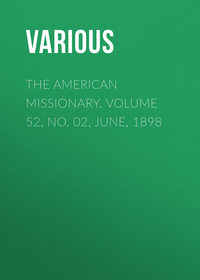 полная версия
полная версияBirds, Illustrated by Color Photography, Vol. 1, No. 6
THE LOGGERHEAD SHRIKE
ARAMBLER in the fields and woodlands during early spring or the latter part of autumn is often surprised at finding insects, grasshoppers, dragon flies, beetles of all kinds, and even larger game, mice, and small birds, impaled on twigs and thorns. This is apparently cruel sport, he observes, if he is unacquainted with the Butcher Bird and his habits, and he at once attributes it to the wanton sport of idle children who have not been led to say,
With hearts to love, with eyes to see,With ears to hear their minstrelsy;Through us no harm, by deed or word,Shall ever come to any bird.If he will look about him, however, the real author of this mischief will soon be detected as he appears with other unfortunate little creatures, which he requires to sustain his own life and that of his nestlings. The offender he finds to be the Shrike of the northern United States, most properly named the Butcher Bird. Like all tyrants he is fierce and brave only in the presence of creatures weaker than himself, and cowers and screams with terror if he sees a falcon. And yet, despite this cruel proceeding, which is an implanted instinct like that of the dog which buries bones he never seeks again, there are few more useful birds than the Shrike. In the summer he lives on insects, ninety-eight per cent. of his food for July and August consisting of insects, mainly grasshoppers; and in winter, when insects are scarce, mice form a very large proportion of his food.
The Butcher Bird has a very agreeable song, which is soft and musical, and he often shows cleverness as a mocker of other birds. He has been taught to whistle parts of tunes, and is as readily tamed as any of our domestic songsters.
The nest is usually found on the outer limbs of trees, often from fifteen to thirty feet from the ground. It is made of long strips of the inner bark of bass-wood, strengthened on the sides with a few dry twigs, stems, and roots, and lined with fine grasses. The eggs are often six in number, of a yellowish or clayey-white, blotched and marbled with dashes of purple, light brown, and purplish gray. Pretty eggs to study.
Readers of Birds who are interested in eggs do not need to disturb the mothers on their nests in order to see and study them. In all the great museums specimens of the eggs of nearly all birds are displayed in cases, and accurately colored plates have been made and published by the Smithsonian Institution and others. The Chicago Academy of Sciences has a fine collection of eggs. Many persons imagine that these institutions engage in cruel slaughter of birds in order to collect eggs and nests. This, of course, is not true, only the fewest number being taken, and with the exclusive object of placing before the people, not for their amusement but rather for their instruction, specimens of birds and animals which shall serve for their identification in forest and field.
The Loggerhead Shrike and nest shown in this number were taken under the direction of Mr. F. M. Woodruff, at Worth, Ill., about fourteen miles from Chicago. The nest was in a corner of an old hedge of Osage Orange, and about eight feet from the ground. He says in the Osprey that it took considerable time and patience to build up a platform of fence boards and old boxes to enable the photographer to do his work. The half-eaten body of a young garter snake was found about midway between the upper surface of the nest and the limb above, where it had been hung up for future use.
THE BALTIMORE ORIOLE
BALTIMORE Orioles are inhabitants of the whole of North America, from Canada to Mexico. They enter Louisiana as soon as spring commences there. The name of Baltimore Oriole has been given it, because its colors of black and orange are those of the family arms of Lord Baltimore, to whom Maryland formerly belonged. Tradition has it that George Calvert, the first Baron Baltimore, worn out and discouraged by the various trials and rigours of temperature experienced in his Newfoundland colony in 1628, visited the Virginia settlement. He explored the waters of the Chesapeake, and found the woods and shores teeming with birds, among them great flocks of Orioles, which so cheered him by their beauty of song and splendor of plumage, that he took them as good omens and adopted their colors for his own.
When the Orioles first arrive the males are in the majority; they sit in the spruces calling by the hour, with lonely querulous notes. In a few days however, the females appear, and then the martial music begins, the birds’ golden trumpeting often turning to a desperate clashing of cymbals when two males engage in combat, for “the Oriole has a temper to match his flaming plumage and fights with a will.”
This Oriole is remarkably familiar, and fearless of man, hanging its beautiful nest upon the garden trees, and even venturing into the street wherever a green tree nourishes. The materials of which its nest is made are flax, various kinds of vegetable fibers, wool, and hair, matted together so as to resemble felt in consistency. A number of long horse-hairs are passed completely through the fibers, sewing it firmly together with large and irregular, but strong and judiciously placed stitching. In one of these nests an observer found that several of the hairs used for this purpose measured two feet in length. The nest is in the form of a long purse, six or seven inches in depth, three or four inches in diameter; at the bottom is arranged a heap of soft material in which the eggs find a warm resting place. The female seems to be the chief architect, receiving a constant supply of materials from her mate, occasionally rejecting the fibers or hairs which he may bring, and sending him off for another load more to her taste.
Like human builders, the bird improves in nest building by practice, the best specimens of architecture being the work of the oldest birds, though some observers deny this.
The eggs are five in number, and their general color is whitish-pink, dotted at the larger end with purplish spots, and covered at the smaller end with a great number of fine intersecting lines of the same hue.
In spring the Oriole’s food seems to be almost entirely of an animal nature, consisting of caterpillars, beetles, and other insects, which it seldom pursues on the wing, but seeks with great activity among the leaves and branches. It also eats ripe fruit. The males of this elegant species of Oriole acquire the full beauty of their plumage the first winter after birth.
The Baltimore Oriole is one of the most interesting features of country landscape, his movements, as he runs among the branches of trees, differing from those of almost all other birds. Watch him clinging by the feet to reach an insect so far away as to require the full extension of the neck, body, and legs without letting go his hold. He glides, as it were, along a small twig, and at other times moves sidewise for a few steps. His motions are elegant and stately.
THE BALTIMORE ORIOLE
About the middle of May, when the leaves are all coming out to see the bright sunshine, you may sometimes see, among the boughs, a bird of beautiful black and orange plumage.
He looks like the Orchard Oriole, whose picture you saw in May “Birds.” It is the Baltimore Oriole. He has other names, such as “Golden Robin,” “Fire Bird,” “Hang-nest.” I could tell you how he came to be called Baltimore Oriole, but would rather you’d ask your teacher about it. She can tell you all about it, and an interesting story it is, I assure you.
You see from the picture why he is called “Hang-nest.” Maybe you can tell why he builds his nest that way.
The Orioles usually select for their nest the longest and slenderest twigs, way out on the highest branches of a large tree. They like the elm best. From this they hang their bag-like nest.
It must be interesting to watch them build the nest, and it requires lots of patience, too, for it usually takes a week or ten days to build it.
They fasten both ends of a string to the twigs between which the nest is to hang. After fastening many strings like this, so as to cross one another, they weave in other strings crosswise, and this makes a sort of bag or pouch. Then they put in the lining.
Of course, it swings and rocks when the wind blows, and what a nice cradle it must be for the baby Orioles?
Orioles like to visit orchards and eat the bugs, beetles and caterpillars that injure the trees and fruit.
There are few birds who do more good in this way than Orioles.
Sometimes they eat grapes from the vines and peck at fruit on the trees. It is usually because they want a drink that they do this.
One good man who had a large orchard and vineyard placed pans of water in different places. Not only the Orioles, but other birds, would go to the pan for a drink, instead of pecking at the fruit. Let us think of this, and when we have a chance, give the birds a drink of water. They will repay us with their sweetest songs.
THE SNOWY OWL
FEW of all the groups of birds have such decided markings, such characteristic distinctions, as the Owl. There is a singular resemblance between the face of an Owl and that of a cat, which is the more notable, as both of these creatures have much the same habits, live on the same prey, and are evidently representatives of the same idea in their different classes. The Owl, in fact, is a winged cat, just as the cat is a furred owl.
The Snowy Owl is one of the handsomest of this group, not so much on account of its size, which is considerable, as by reason of the beautiful white mantle which it wears, and the large orange eyeballs that shine with the lustre of a topaz set among the snowy plumage.
It is a native of the north of Europe and America, but is also found in the more northern parts of England, being seen, though rather a scarce bird, in the Shetland and Orkney Islands, where it builds its nest and rears its young. One will be more likely to find this owl near the shore, along the line of salt marshes and woody stubble, than further inland. The marshes do not freeze so easily or deep as the iron bound uplands, and field-mice are more plentiful in them. It is so fleet of wing that if its appetite is whetted, it can follow and capture a Snow Bunting or a Junco in its most rapid flight.
Like the Hawk Owl, it is a day-flying bird, and is a terrible foe to the smaller mammalia, and to various birds. Mr. Yarrell in his “History of the British Birds,” states that one wounded on the Isle of Balta disgorged a young rabbit whole, and that a young Sandpiper, with its plumage entire, was found in the stomach of another.
In proportion to its size the Snowy Owl is a mighty hunter, having been detected chasing the American hare, and carrying off wounded Grouse before the sportsman could secure his prey. It is also a good fisherman, posting itself on some convenient spot overhanging the water, and securing its finny prey with a lightning-like grasp of the claw as it passes beneath the white clad fisher. Sometimes it will sail over the surface of a stream, and snatch the fish as they rise for food. It is also a great lover of lemmings, and in the destruction of these quadruped pests does infinite service to the agriculturist.
The large round eyes of this owl are very beautiful. Even by daylight they are remarkable for their gem-like sheen, but in the evening they are even more attractive, glowing like balls of living fire.
From sheer fatigue these birds often seek a temporary resting place on passing ships. A solitary owl, after a long journey, settled on the rigging of a ship one night. A sailor who was ordered aloft, terrified by the two glowing eyes that suddenly opened upon his own, descended hurriedly to the deck, declaring to the crew that he had seen “Davy Jones a-sitting up there on the main yard.”
THE SNOWY OWL
What do you think of this bird with his round, puffy head? You of course know it is an Owl. I want you to know him as the Snowy Owl.
Don’t you think his face is some like that of your cat? This fellow is not full grown, but only a child. If he were full grown he would be pure white. The dark color you see is only the tips of the feathers. You can’t see his beak very well for the soft feathers almost cover it.
His large soft eyes look very pretty out of the white feathers. What color would you call them? Most owls are quiet during the day and very busy all night. The Snowy Owl is not so quiet day times. He flies about considerably and gets most of his food in daylight.
A hunter who was resting under a tree, on the bank of a river, tells this of him:
“A Snowy Owl was perched on the branch of a dead tree that had fallen into the river. He sat there looking into the water and blinking his large eyes.
Suddenly he reached out and before I could see how he did it, a fish was in his claws.”
This certainly shows that he can see well in the day time. He can see best, however, in the twilight, in cloudy weather or moonlight. That is the way with your cat.
The wing feathers of the owl are different from those of most birds. They are as soft as down. This is why you cannot hear him when he flies. Owls while perching are almost always found in quiet places where they will not be disturbed.
Did you ever hear the voice of an owl in the night? If you never have, you cannot imagine how dreary it sounds. He surely is “The Bird of the Night.”
BIRDS AND FARMERS
From the Forest and StreamTHE advocates of protection for our small birds present two sets of reasons for preventing their killing; the one sentimental, and the other economic.
The sentimental reasons are the ones most often urged; they are also of a kind to appeal with especial force to those whose responsibility for the destruction of the birds is greatest. The women and girls, for whose adornment birds’ plumage is chiefly used, think little and know less about the services which birds perform for agriculture, and indeed it may be doubted whether the sight of a bunch of feathers or a stuffed bird’s skin suggests to them any thought of the life that those feathers once represented. But when the wearers are reminded that there was such a life; that it was cheery and beautiful, and that it was cut short merely that their apparel might be adorned, they are quick to recognize that bird destruction involves a wrong, and are ready to do their part toward ending it by refusing to wear plumage.
The small boy who pursues little birds from the standpoint of the hunter in quest of his game, feels only the ardor of pursuit. His whole mind is concentrated on that and the hunter’s selfishness, the desire of possession, fills his heart. Ignorance and thoughtlessness destroy the birds.
Every one knows in a general way that birds render most valuable service to the farmer, but although these services have long been recognized in the laws standing on the statute books of the various states, it is only within a few years that any systematic investigations have been undertaken to determine just what such services are, to measure them with some approach to accuracy, to weigh in the case of each species the good and the evil done, and so to strike a balance in favor of the bird or against it. The inquiries carried on by the Agricultural Department on a large scale and those made by various local experiment stations and by individual observers have given results which are very striking and which can no longer be ignored.
It is a difficult matter for any one to balance the good things that he reads and believes about any animal against the bad things that he actually sees. The man who witnesses the theft of his cherries by robin or catbird, or the killing of a quail by a marsh hawk, feels that here he has ocular proof of harm done by the birds, while as to the insects or the field mice destroyed, and the crops saved, he has only the testimony of some unknown and distant witness. It is only natural that the observer should trust the evidence of his senses, and yet his eyes tell him only a small part of the truth, and that small part a misleading one.
It is certain that without the services of these feathered laborers, whose work is unseen, though it lasts from daylight till dark through every day in the year, agriculture in this country would come to an immediate standstill, and if in the brief season of fruit each one of these workers levies on the farmer the tribute of a few berries, the price is surely a small one to pay for the great good done. Superficial persons imagine that the birds are here only during the summer, but this is a great mistake. It is true that in warm weather, when insect life is most abundant, birds are also most abundant. They wage an effective and unceasing war against the adult insects and their larvae, and check their active depredations; but in winter the birds carry on a campaign which is hardly less important in its results.
THE SCARLET TANAGER
ONE of the most brilliant and striking of all American birds is the Scarlet Tanager. From its black wings resembling pockets, it is frequently called the “Pocket Bird.” The French call it the “Cardinal.” The female is plain olive-green, and when seen together the pair present a curious example of the prodigality with which mother nature pours out her favors of beauty in the adornment of some of her creatures and seems niggardly in her treatment of others. Still it is only by contrast that we are enabled to appreciate the quality of beauty, which in this case is of the rarest sort. In the January number of Birds we presented the Red Rumped Tanager, a Costa Rica bird, which, however, is inferior in brilliancy to the Scarlet, whose range extends from eastern United States, north to southern Canada, west to the great plains, and south in winter to northern South America. It inhabits woodlands and swampy places. The nesting season begins in the latter part of May, the nest being built in low thick woods or on the skirting of tangled thickets; very often also, in an orchard, on the horizontal limb of a low tree or sapling. It is very flat and loosely made of twigs and fine bark strips and lined with rootlets and fibers of inner bark.
The eggs are from three to five in number, and of a greenish blue, speckled and blotted with brown, chiefly at the larger end.
The disposition of the Scarlet Tanager is retiring, in which respect he differs greatly from the Summer Tanager, which frequents open groves, and often visits towns and cities. A few may be seen in our parks, and now and then children have picked up the bright dead form from the green grass, and wondered what might be its name. Compare it with the Redbird, with which it is often confounded, and the contrast will be striking.
His call is a warble, broken by a pensive call note, sounding like the syllables chip-churr, and he is regarded as a superior musician.
“Passing through an orchard, and seeing one of these young birds that had but lately left the nest, I carried it with me for about half a mile to show it to a friend, and having procured a cage,” says Wilson, “hung it upon one of the large pine trees in the Botanic Garden, within a few feet of the nest of an Orchard Oriole, which also contained young, hoping that the charity and kindness of the Orioles would induce them to supply the cravings of the stranger. But charity with them as with too many of the human race, began and ended at home. The poor orphan was altogether neglected, and as it refused to be fed by me, I was about to return it to the place where I had found it, when, toward the afternoon, a Scarlet Tanager, no doubt its own parent, was seen fluttering around the cage, endeavoring to get in. Finding he could not, he flew off, and soon returned with food in his bill, and continued to feed it until after sunset, taking up his lodgings on the higher branches of the same tree. In the morning, as soon as day broke, he was again seen most actively engaged in the same manner, and, notwithstanding the insolence of the Orioles, he continued his benevolent offices the whole day, roosting at night as before. On the third or fourth day he seemed extremely solicitous for the liberation of his charge, using every expression of distressful anxiety, and every call and invitation that nature had put in his power, for him to come out. This was too much for the feelings of my friend. He procured a ladder, and mounting to the spot where the bird was suspended, opened the cage, took out his prisoner, and restored him to liberty and to his parent, who, with notes of great exultation, accompanied his flight to the woods.”
THE SCARLET TANAGER
What could be more beautiful to see than this bird among the green leaves of a tree? It almost seems as though he would kindle the dry limb upon which he perches. This is his holiday dress. He wears it during the nesting season. After the young are reared and the summer months gone, he changes his coat. We then find him dressed in a dull yellowish green – the color of his mate the whole year.
Do you remember another bird family in which the father bird changes his dress each spring and autumn?
The Scarlet Tanager is a solitary bird. He likes the deep woods, and seeks the topmost branches. He likes, too, the thick evergreens. Here he sings through the summer days. We often pass him by for he is hidden by the green leaves above us.
He is sometimes called our “Bird of Paradise.”
Tanagers feed upon winged insects, caterpillars, seeds, and berries. To get these they do not need to be on the ground. For this reason it is seldom we see them there.
Both birds work in building the nest, and both share in caring for the little ones. The nest is not a very pretty one – not pretty enough for so beautiful a bird, I think. It is woven so loosely that if you were standing under it, you could see light through it.
Notice his strong, short beak. Now turn to the picture of the Rose-Breasted Grosbeaks in April Birds. Do you see how much alike they are? They are near relatives.
I hope that you may all have a chance to see a Scarlet Tanager dressed in his richest scarlet and most jetty black.
THE RUFFED GROUSE
THE Ruffed Grouse, which is called Partridge in New England and Pheasant in the Middle and Southern States, is the true Grouse, while Bob White is the real Partridge. It is unfortunate that they continue to be confounded. The fine picture of his grouseship, however, which we here present should go far to make clear the difference between them.
The range of the Ruffed Grouse is eastern United States, south to North Carolina, Georgia, Mississippi, and Arkansas. They hatch in April, the young immediately leaving the nest with the mother. When they hear the mother’s warning note the little ones dive under leaves and bushes, while she leads the pursuer off in an opposite direction. Building the nest and sitting upon the eggs constitute the duties of the female, the males during this interesting season keeping separate, not rejoining their mates until the young are hatched, when they begin to roam as a family.
Like the Turkey, the Ruffed Grouse has a habit of pluming and strutting, and also makes the drumming noise which has caused so much discussion. This noise “is a hollow vibrating sound, beginning softly and increasing as if a small rubber ball were dropped slowly and then rapidly bounced on a drum.” While drumming the bird contrives to make himself invisible, and if seen it is difficult to get the slightest clue to the manner in which the sound is produced. And observers say that it beats with its wings on a log, that it raises its wings and strikes their edges above its back, that it claps them against its sides like a crowing rooster, and that it beats the air. The writer has seen a grouse drum, appearing to strike its wings together over its back. But there is much difference of opinion on the subject, and young observers may settle the question for themselves. When preparing to drum he seems fidgety and nervous and his sides are inflated. Letting his wings droop, he flaps them so fast that they make one continuous humming sound. In this peculiar way he calls his mate, and while he is still drumming, the hen bird may appear, coming slyly from the leaves.
The nest is on the ground, made by the female of dry leaves and a few feathers plucked from her own breast. In this slight structure she lays ten or twelve cream-colored eggs, specked with brown.











